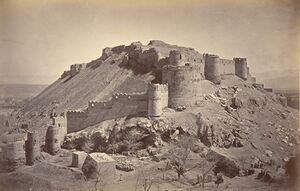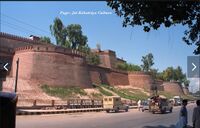Bala Hissar
| Author:Laxman Burdak, IFS (Retd.) |

Bala Hissar (बाला हिसार) is an ancient fortress located in the city of Kabul, Afghanistan. The estimated date of construction is around the 5th century A.D.[1]
Variants
- Bal Hisar (बल हिसार)
- Bala-e-Hissar
- Balut Hesar (Persian: بلوطحصار)
- Balūţ Ḩeşār
- Balooţ Ḩeşār
- Bālā Ḩeşār
- Bala Hisār
Origin of name
Bal Hisar or Mood Hisar or Hisar are in Afghanistan. Bal Hisar city is said to be founded by Balhara gotra Jats and Mood Hisar city by Moond gotra Jats in Afghanistan.[2]
Location
Bala Hissar sits to the south of the modern city centre at the tail end of the Kuh-e-Sherdarwaza Mountain. Bala Hissar was originally divided into two parts: The lower fortress, containing the stables, barracks and three royal palaces, and the upper fortress (the actual fort with the name Bala Hissar) housing the armory and the dungeon of Kabul, known as the "Black Pit" (the Siyah Chal).
History
Bala Hissar, Kabul
Bala Hissar ("High Fort") is an ancient fortress located in the south of the old city of Kabul, Afghanistan. The estimated date of construction is around the 5th century AD.[1] Bala Hissar sits to the south of the modern city centre at the tail end of the Kuh-e-Sherdarwaza Mountain. The Walls of Kabul, which are 20 feet (6.1 m) high and 12 feet (3.7 m) thick, start at the fortress and follow the mountain ridge in a sweeping curve down to the river. It sports a set of gates for access to the fortress. The Kōh-e Shēr Darwāzah (lion door) mountain is behind the fort.
Bala Hissar was originally divided into two parts: The lower fortress, containing the stables, barracks and three royal palaces, and the upper fortress (the actual fort with the name Bala Hissar) housing the armory and the dungeon of Kabul, known as the "Black Pit" (the Siyah Chal).
The Second Battle of Panipat was fought in 1556 between the forces of Akbar and Hemu, a Hindu king.[3][4] Hemu had the larger army, and initially his forces were winning, but during the Elephant charge he was wounded leading his forces by an arrow and taken prisoner.[5] When he was brought before the Mughal commanders, Bairam Khan killed him.[6]] Hemu's head was sent to Kabul where it was hung outside the Delhi Darwaza of Bala Hissar, Kabul while his body was placed in a gibbet outside Purana Quila in Delhi to terrorise his remaining supporters.
As Kabul's principal fortress, Bala Hissar was an important site both in the First (1838–1842) and Second Anglo-Afghan War (1878–1880).[7]
The British envoy to Kabul, Sir Pierre Louis Napoleon Cavagnari was murdered inside the fort in September 1879 triggering a general uprising and the second phase of the Second Anglo-Afghan War.[8]
It was damaged during the Second Anglo-Afghan War when the British Residency was burned down, then later when the armoury exploded. General Frederick Roberts had wanted to level the fortress completely, but in the end it was strengthened and fortified in the Spring of 1880, a few months before the British left Afghanistan.[9]
Bala Hissar was the site of some of the bloodiest fighting in Afghanistan during the 19th century when Afghanistan came into conflict with the invading British during the First Anglo-Afghan War (1838–1842) and Second Anglo-Afghan War (1878–1880). From 1839 onwards the British used it on and off as their barracks until the massacre of the British Mission by mutinous Afghan troops in 1879. It was damaged during the Second Anglo-Afghan War when the British Residency was burned down, then later when the armoury exploded. General Frederick Roberts had wanted to level the fortress completely, but in the end it was strengthened and fortified in the Spring of 1880, a few months before the British left Afghanistan..
When looking at the outer wall of the fortress, it is possible to see layers of building materials from years of destruction and re-fortification. The tanks and other war wreckage from the last 30 years are strewn about the top of the hillside. Much of the hillside is built up on tunnels and underground storage. Evidence of trenches from previous trench warfare encircles the upper most level of the hilltop, which is adorned with a rickety, stalwart Afghan flag.
पुष्कलावती
विजयेन्द्र कुमार माथुर[10] ने लेख किया है ...पुष्कलावती (AS, p.572): भारत के सीमांत प्रदेश पर स्थित अति प्राचीन नगरी जिसका अभिज्ञान जिला पेशावर (पाकिस्तान) के चारसड्डा नामक स्थान (पेशावर से 17 मील उत्तर-पूर्व) से किया गया है. कुमारस्वामी के अनुसार यह नगरी स्वात (प्राचीन सुवास्तु) और काबुल (प्राचीन कुभा) नदियों के संगम पर बसी हुई थी जहां वर्तमान मीर जियारत या बालाहिसार है (इंडियन एंड इंडोनेशियन आर्ट,पृ.55). वाल्मीकि रामायण में पुष्कलावत या पुष्कलावती का भरत के पुत्र पुष्कल के नाम पर बसाया जाना उल्लिखित है--'तक्षं तक्षशिलायां तु पुष्कलं पुष्कलावते गंधर्वदेशे रुचिरे गांधार-विषये ये च स:' बाल्मीकि उत्तरकांड 101,11. रामायण काल में गंधार-विषय के पश्चिमी भाग की राजधानी पुष्कलावती में थी. सिंधु नदी के पश्चिम में पुष्कलावती और पूर्व में तक्षशिला भरत ने अपने पुत्र पुष्कल और तक्ष के नाम पर बसाई थीं. इस काल में यहां गंधर्वों का राज्य था जिनके आक्रमण से तंग आकर भरत के मामा केकय-नरेश युधाजित् ने उनके विरुद्ध श्री रामचंद्रजी से सहायता मांगी थी. इसी प्रार्थना के फलस्वरूप उन्होंने भरत को युधाजित् की ओर से गंधर्वों से लड़ने के लिए भेजा था. गंधर्वों को हटाकर भरत ने पुष्कलावती और तक्षशिला - ये दो नगर इस प्रदेश में बसाए थे.
कालिदास ने रघुवंश में भी पुष्कल के नाम पर ही पुष्कलावती के बसाए जाने का उल्लेख किया है-- 'स तक्षपुष्कलौ पुत्रौ राजधान्योस्तदाख्ययोः । अभिषिच्याभिषेकार्हौ रामान्तिकं अगात्पुनः' (रघुवंश 15,89)
प्रकृत या पाली बौद्ध ग्रंथों में पुष्कलावती को पुक्कलाओति कहा गया है-- ग्रीक लेखक एरियन ने इसे प्युकेलाटोइस (Peucelatois) लिखा है. बौद्धकाल में गांधार-मूर्तिकला की अनेक सुंदर कृतियां पुष्कलावती में बनी थीं और यह स्थान ग्रीक-भारतीय सांस्कृतिक आदान-प्रदान का केंद्र था. गुप्तकाल में इसी स्थान पर रहते हुए वसुमित्र ने 'अभिधर्म प्रकरण' रचा था. नगर के पूर्व की ओर अशोक का बनवाया हुआ धर्मराजिक स्तूप था. पास ही इन्हीं का निर्मित पत्थर और लकड़ी का बना 60 हाथ ऊंचा दूसरा था. बौद्ध किंवदंती के अनुसार यहां से 6 कोस पर वह स्तूप था जहां भगवान तथागत ने यक्षिणी हारीति का दमन किया था. पश्चिमी नगर-द्वार के बाहर महेश्वर शिव (पशुपति) का एक विशाल मंदिर था.
प्रसिद्ध चीनी यात्री युवानच्वांग ने पुष्कलावती के बौद्ध कालीन गौरव का वर्णन किया है जिसकी पुष्टि यहां के [पृ.573]: तक खंडहरों से प्राप्त अवशेषों से होती है. पुष्कलावती नगरी के स्थान पर वर्तमान अश्तनगर या इश्तनगर कस्बा बसा हुआ है. अश्तनगर का शुद्ध रूप अस्थिनगर है. यहां के स्तूप में बुद्ध की अस्थि या भस्म धातुगर्भ के भीतर सुरक्षित थी.
Bala Hissar, Peshawar

The word Bala Hissar is from Dari Persian, meaning, "elevated or high fort". The name was given by the Afghan Pashtun King Timur Shah Durrani (1773–1793), who used the fort as the winter capital of the Durrani Empire.
Bala Hisar, Iran
Balut Hesar (Persian: بلوطحصار, also Romanized as Balūţ Ḩeşār and Balooţ Ḩeşār; also known as Bālā Ḩeşār and Bala Hisār)[11] is a village in Kafsh Kanan Rural District, in the Central District of Bahmai County, Kohgiluyeh and Boyer-Ahmad Province, Iran.
इतिहास
ठाकुर देशराज[12] ने लिखा है .... पंजाब के हिसार जिले को सभी लोग जाटों का जिला मानते हैं। ईरान में जगातू नदी के पास हिसार एक प्रसिद्ध शहर रह चुका है। अब तो वह उजाड़ पड़ा है। ईरान के हिसार
[पृ.153]: पास |सेई कलह और सहना दो प्रसिद्ध स्थान हैं। हम नहीं जानते पंजाब के हिसार के पास भी इन्हीं नाम के जाटों के कोई नगर हैं या नहीं। इसके अलावा दो हिसार हम अफगानिस्तान के भूगोल में आज भी पढ़ते हैं। एक बाला हिसार और दूसरा मूंदा हिसार है। क्या इन में से एक हो बालाइन जाटों का और दूसरे को मूंद जाटों का हिसाब कहना उचित नहीं होगा।
References
- ↑ Upper Bala Hissar from west Kabul
- ↑ Jat Samaj, Agra : March 1998
- ↑ Richards, John F. (1995) [First published 1993]. The Mughal Empire. The New Cambridge History of India. Cambridge University Press. p. 13. ISBN 978-0-521-56603-2.
- ↑ Kolff, Dirk H. A. (2002) [First published 1990]. Naukar, Rajput, and Sepoy: The Ethnohistory of the Military Labour Market of Hindustan, 1450-1850. Cambridge University Press. p. 163. ISBN 978-0-521-52305-9.
- ↑ Richards, John F. (1995) [First published 1993]. The Mughal Empire. The New Cambridge History of India. Cambridge University Press. p. 13. ISBN 978-0-521-56603-2.
- ↑ Malleson, George Bruce (1890). Akbar and the rise of the Mughal Empire. Oxford: Clarendon Press. p. 71.
- ↑ Caption for Panorama of the Bala Hissar WDL11486 Library of Congress
- ↑ Caption for Panorama of the Bala Hissar WDL11486 Library of Congress
- ↑ Caption for Panorama of the Bala Hissar WDL11486 Library of Congress
- ↑ Aitihasik Sthanavali by Vijayendra Kumar Mathur, p.572
- ↑ Balut Hesar can be found at GEOnet Names Server, at this link, by opening the Advanced Search box, entering "-3055029" in the "Unique Feature Id" form, and clicking on "Search Database".
- ↑ Thakur Deshraj: Jat Itihas (Utpatti Aur Gaurav Khand)/Navam Parichhed,p.152-153
Back to Jat Places in Afghanistan

